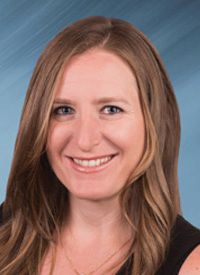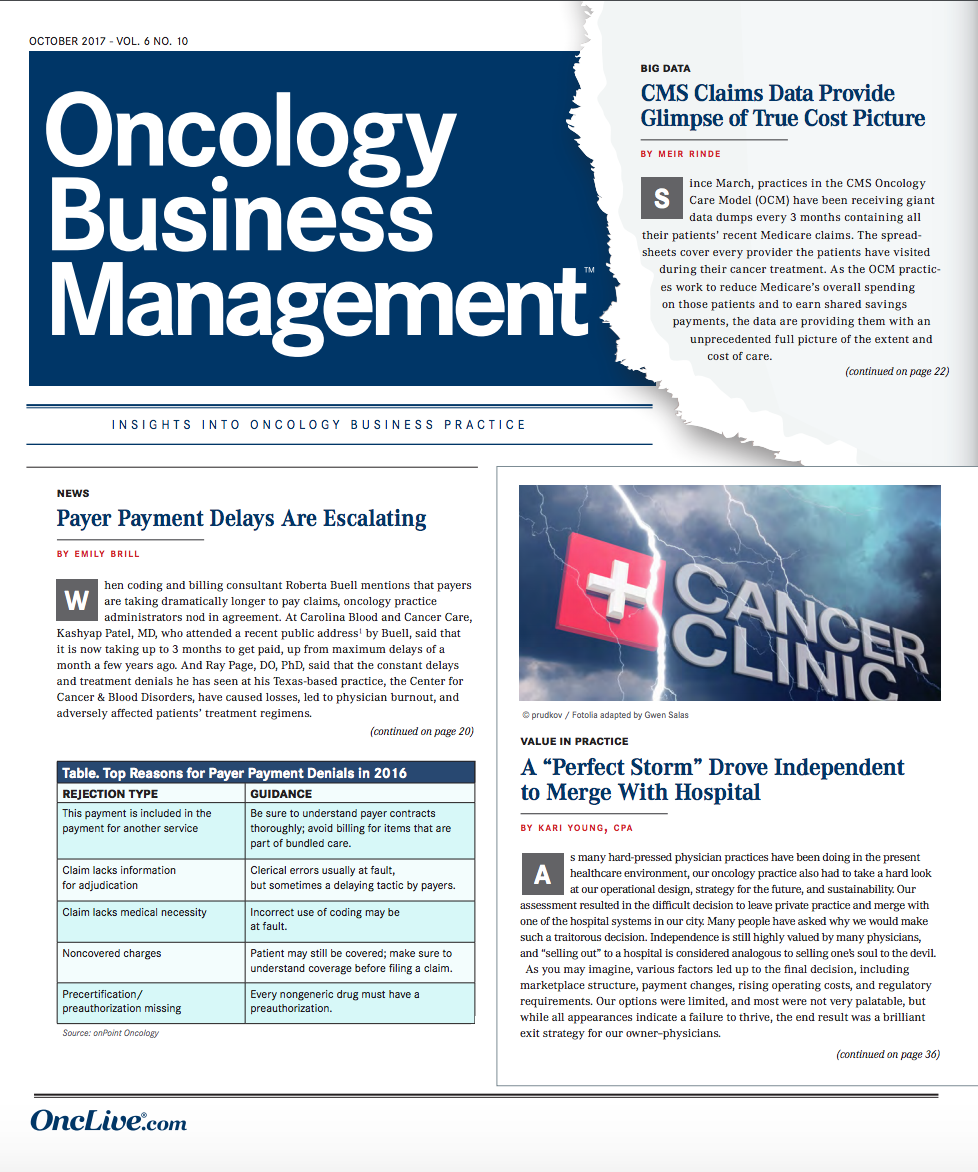Publication
Article
Oncology Business News®
CMS Claims Data Provide Glimpse of True Cost Picture
Author(s):
As the Oncology Care Model practices work to reduce Medicare’s overall spending on those patients and to earn shared savings payments, the data are providing them with an unprecedented full picture of the extent and cost of care.
Sarah Cevallos

Sarah Cevallos
Since March, practices in the CMS Oncology Care Model (OCM) have been receiving giant data dumps every 3 months containing all their patients’ recent Medicare claims. The spreadsheets cover every provider the patients have visited during their cancer treatment. As the OCM practices work to reduce Medicare’s overall spending on those patients and to earn shared savings payments, the data are providing them with an unprecedented full picture of the extent and cost of care.
“When it first came out, the reaction was, ‘Wow,’” said Robert “Bo” Gamble, director of strategic practice initiatives at the Community Oncology Alliance (COA). “Practices have never known, and now they do. Now they can respond to it.” (Figures 1, 2)
Figure 1. Practices Have Used CMS Data to Calculate Total Costs of Care
Figure 2. Oncology Care Model Practices Track Inpatient Admission Rates by Physician
For many practices, the data feed confirmed that steps they had already taken, such as encouraging patients to call in when they feel nauseated or dehydrated, had already reduced emergency department (ED) visits and hospitalizations. In some places, managers quickly noticed high costs or overuse of services at outside providers, pointing them toward ways to further reduce spending.
Northwest Medical Specialties, a practice in Tacoma, Washington, with 9 oncologists and 6 other physicians, studied the data and was pleased to learn it had reduced ED admissions by 25% and hospital readmissions by 15% compared with an earlier, baseline period, said COO Jeff Hunnicutt. He said it was also “really exciting” to link the Medicare claims to detailed clinical data that the practice has been collecting in its electronic medical record. That allowed comparisons of spending on different disease stages and insights into the cost impact of psychosocial factors such as living alone or living with a disability.
Another feature is greater transparency on how other providers operate and how much they charge Medicare for services. “It just kind of confirms the suspicions you’ve always had, that hospitals are ridiculously more expensive than community oncology. You see things like a flow cytometry test that costs $1000 in our clinic. If they do it in a hospital, it’s $4800 for the exact same process. There are hundreds of things like that,” Hunnicutt said.
The staff noticed one local hospital has a much higher admission rate than others and reached out to ask why. “We came to find out it was an internal directive that oncology patients who came into the ED were almost exclusively admitted to the hospital, which we look at as just being shocking. That hospital is doing something we would not think is morally in the best interests of the patient,” Hunnicutt said. The hospital’s reasons may include the resulting profit as well as fears about managing oncology in the ED, he said. Northwest Medical voiced concerns but is not discouraging patients from using the hospital, because it is convenient for them and is an important source of referrals for the practice, Hunnicutt said.
Another practice that gained useful data on partner providers is Florida Cancer Specialists & Research Institute, one of the largest OCM participants, with more than 200 physicians at close to 100 locations. Chief revenue cycle officer Sarah Cevallos said the data feed validated the practice’s understanding of differences in hospital costs among regions and allowed the organization to “slice and dice” the numbers to identify which specific diagnosis, disease, therapy, office location, or other variable represented a challenge or opportunity.
For example, the data seemed to indicate that some Florida Cancer Specialists & Research Institute clinics were making unusually high rates of referrals to hospice, which was very concerning, Cevallos said. Further investigation of one site revealed that patients were frequently referred but not necessarily admitted to a particular hospice. It turned out the hospice provider was undergoing an ownership change, and its relationship with the clinic was in flux.
“There was confusion about whether patients were actually in or out of hospice. The patient was referred to hospice: Well, what does that mean? There was just a ton of back and forth, figuring out where that definition lies and making sure we can tighten those words up so there’s no confusion in the marketplace,” Cevallos said. Examining the data closely led to an opportunity to improve communication and ensure patients were getting palliative care services at the right time, she added.
A clinic’s internal performance can also be minutely analyzed once the CMS data are processed. One common use is to check which physicians’ patients end up in the hospital more often. If the information is interpreted and communicated carefully, with an understanding of the varying disease intensities of different cancers, it can create a good opportunity to help physicians improve their patients’ outcomes, said Basit Chaudhry, MD, founder of Tuple Health. Chaudhry is an expert on value-based care models who analyzes claims data for Florida Cancer Specialists & Research Institute and several other practices and also works with COA’s support network for OCM participants.
In some cases, Chaudhry will recommend that a doctor whose patients are frequently hospitalized get more support from medical assistants and care managers. For example, the practice may need to do a better job with medical reconciliation, the time-consuming process of correcting the list of medications a patient is taking. Patients are often told to suspend certain prescriptions when they are hospitalized, causing confusion later and leading to adverse drug events. Instituting a staff process for keeping it up to date can help prevent readmissions.
“A lot of success in value-based payment is in helping clinicians practice at the top of their license and creating support structures with a team around that,” Chaudhry said. “You really want to free up the oncologists and the treatment nurses to do what they do best and allocate a lot of the other processes to other health professionals or other business functions. Medication reconciliation is a good one.”
Although practices are gaining useful insights from the data, they are also wrestling with the sheer complexity and quirks in their presentation. While the feed includes a short, readable summary of key points, such as a comparison of total costs with those of other practices, the raw claims data come in 23 separate files that must be decoded and integrated. Some practices, like Northwest Medical, have technical staff who can process the files, but Florida Cancer Specialists & Research Institute and many others use outside analytics firms like Tuple Health. Smaller practices may not be able to afford such services or may question whether the benefits are sufficient to merit the cost.
The most prevalent complaints concern treatment episodes and patient attribution. Performance in the OCM will be evaluated based on total cost of care and quality measures during 6-month episodes. Starting next year, practices will receive rewards based on how well they beat their cost targets as well as on their quality metrics and certain other factors. They are eager to see how they are doing so far so they can understand whether the model will be financially viable for them in the long run. That understanding is critical as they decide whether to join the 2-sided risk version of the OCM, which promises substantial performance-based payments and potentially ruinous penalties.
However, CMS does not make it easy to reach that understanding. The claims data are not structured into episodes, in part because that can be done only retroactively, once it is clear which patients an OCM practice is financially responsible for. Some patients may visit a clinic only once or twice before deciding to be treated elsewhere, while others may move away mid-treatment or enter hospice. Under the OCM, they will eventually be attributed to the provider they have seen the most times. Yet all their claims are currently in the practices’ data feeds, even if they visited only once.
Understanding Shared Savings
“Practices can’t construct a target price or even a precursor to the target price, to have an idea of what their financial risk or savings would be,” said Alyssa Dahl, principal healthcare informatics analyst at Datagen, which processes OCM data for about 15 practices, most of them academic medical centers. “It would be more beneficial to practices if they had some way to know how things are going because at the end of the day, it is a financial program. They have the best intentions of improving patient care, and there are wonderful practice transformation pieces of it, but the way to keep practices in this is to also help them find ways that they can save money.”In addition to attribution, there’s a “huge list” of potential adjustments based on age, race, diabetes status, various diagnosis codes, and other factors that will be used to determine shared savings, Gamble, of COA, said. Many practices do not understand how these adjustments work. “It’s a bear. To our knowledge, there is not a single practice of the 192 OCM teams that has elected to take 2-sided risk. If you made a model that was easier to understand and more transparent, and people could follow that model and apply their own math, you may just have somebody who does 2-sided risk. Until you do, I doubt it,” he said.
CMS will not release the first episode-based reconciliation with scores until February, but Hunnicutt said he has already used the agency’s explanatory materials to better understand the scoring system. He has noted the effects of variables like research trial participation and low-income status, which modify the target price and make it easier for a practice to achieve savings. “We have a really robust research program here, but it’s making us look even closer. Are there other clinical trials that patients could qualify for? It’s going to benefit [not only] the patient, but that target price going up obviously benefits the practice,” Hunnicutt said.
Among other concerns, Chaudhry and Cevallos said they would like to get new claims data monthly or even weekly so they can spot and address problems as they are happening. Gamble said another major data-related challenge is the clinical registry, a list of 60 clinical elements that practices are required to periodically report to CMS so the agency can develop oncology bundled payments. “We hear only anxiety and frustration from practices. Some of the data being requested make no sense. Some of it doesn’t even exist,” Gamble said. “If we could lift that, that would make this model much better.”










